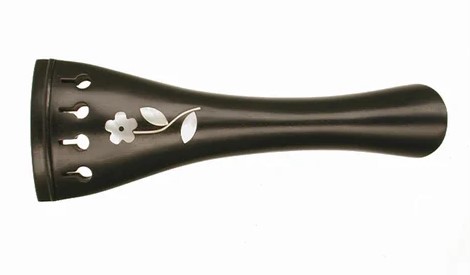How Your Violin’s Tailpiece Impacts Tone & Playability

Introduction:
The Subtle Power of the Violin Tailpiece
For many violinists—especially beginners and even some intermediate players—the tailpiece might seem like just another part of the instrument’s anatomy. It doesn’t have strings vibrating through it like the fingerboard, it doesn’t have a bow gliding over it like the bridge, and it certainly doesn’t catch the eye like a scroll. However, this small, humble component plays a surprisingly significant role in both the tone and playability of the violin. From adjusting the afterlength of your strings to impacting resonance and string tension, the tailpiece is one of the most underrated yet impactful parts of your setup.
Understanding the importance of your tailpiece can help you refine your sound, optimize comfort, and ultimately bring out the best in your instrument. Whether you’re a student, a serious amateur, or a professional, learning how this component influences performance may change the way you approach violin maintenance and customization. Let’s explore the fascinating relationship between your violin’s tailpiece, its tonal qualities, and your playing experience.
What Is a Tailpiece and What Does It Do?
The tailpiece is the component that anchors the strings at the bottom end of the violin, opposite the pegs. It’s typically made from materials like ebony, boxwood, rosewood, or composite synthetics like carbon fiber or plastic. It is connected to the end button with a tailgut or nylon loop, holding the tailpiece at a specific tension and height above the body of the violin.
Its primary function is structural—to secure the strings in place—but that’s just the beginning. It also affects the afterlength, which is the segment of the string between the bridge and the tailpiece. This segment plays a significant role in resonance and sympathetic vibration, influencing everything from overtone richness to tuning stability.
How Tailpiece Design Affects Tone
- Material Matters
Different materials resonate differently. A tailpiece made of ebony tends to be heavier, which can provide a more focused and darker tone. In contrast, lighter materials like boxwood or composite carbon fiber may produce a brighter, more open sound.
- Heavier tailpieces: Mute unwanted overtones, offering a more controlled, sometimes warmer tone.
- Lighter tailpieces: Allow more resonance, often producing a more vibrant and projecting tone.
The material choice should ideally complement your instrument’s natural characteristics. A dark-sounding violin may benefit from a lighter tailpiece, while a brighter one might be tamed by a denser material.
- Shape and Weight Distribution
The shape and contour of the tailpiece influence how vibrations travel through the instrument. Some are sculpted to be aerodynamic and allow freer movement of string energy, while others are blockier and more rigid, which can dampen excessive resonance.
A well-designed tailpiece ensures that vibrations are efficiently transmitted while keeping unwanted sympathetic resonances in check. This contributes to tonal clarity and projection.
- Fine Tuners and Their Impact
Most violin tailpieces come with built-in fine tuners or have the option to add them. While these are essential for easy tuning—especially for students or when using metal strings—they also add weight. A tailpiece loaded with four metal fine tuners can become quite heavy, which may mute some of the instrument’s resonance.
Many advanced players use only one fine tuner on the E string, keeping the rest as light as possible. Others opt for tailpieces with integrated fine tuners made of lighter materials to strike a balance between function and tone.
Tailpiece and Playability
String Spacing and Tension
The tailpiece contributes to how the strings feel under your fingers. By determining the distance between string holes and how strings are anchored, it affects overall tension and spacing.
A wider tailpiece can increase string spacing, which might be more comfortable for some players. Likewise, adjustments in tailgut length and tension can raise or lower the tailpiece, changing the string angle over the bridge and ultimately influencing both tone and playability.
Afterlength and Wolf Tones
Fine-tuning the afterlength (the portion of the string between the bridge and tailpiece) can help reduce or eliminate wolf tones and improve resonance. A luthier may suggest string adjusters or fine modifications to the tailpiece setup to optimize these effects. This is especially important for professional players seeking maximum tonal richness and minimal interference.
Conclusion:
Don’t Overlook the Tailpiece
Although small in size, the tailpiece holds major sway over your violin’s tone and responsiveness. The material, design, weight, and even how it’s attached to the instrument all contribute to how the violin sounds and feels. Whether you’re looking to brighten a dark instrument, tame an overly resonant one, or simply make tuning easier without sacrificing tone, the right tailpiece can make a profound difference.
It’s easy to overlook this component in favor of strings, bows, or even rosin—but smart players know that everything matters in the search for beautiful sound. If you haven’t thought about your tailpiece lately, now might be the time to take a closer look. Consulting with a qualified luthier can help you choose the ideal tailpiece for your instrument, unlocking new dimensions of tone and playability that you might not have realized were just a small adjustment away.
Enhance Your Violin’s Performance with KINGLAR
Looking to upgrade your tailpiece or fine-tune your violin for better tone and playability? Trust KINGLAR—your reliable destination for high-quality violin parts and expert craftsmanship. From premium tailpieces to personalize setup advice, we help musicians bring out the best in their instruments.
Visit Us:
KINGLAR
155/1, Main Road East,
New Barrackpore, West Bengal, India
Call: +91-9051144332
Website: www.kinglarviolin.com
Email: kinglarviolin@hotmail.com
Get in touch today to find the perfect tailpiece and experience the difference in tone and playability!

Leave a Reply